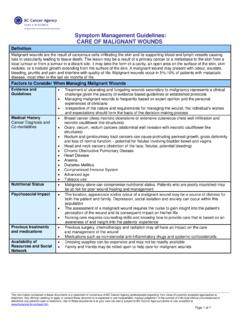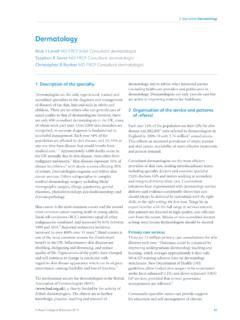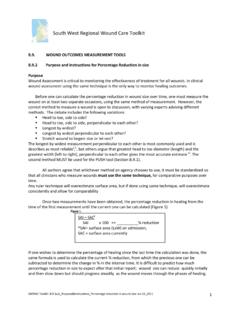Transcription of O MANAGEMENT OF MALIGNANT FUNGATING …
1 OBJECTIVE:To review the pathophysiologyand assessment of malignantwounds and MANAGEMENT tech-niques aimed at controlling pain,odor, exudate, and local :Current research and : assessment of MALIGNANT wounds,selection of appropriate dressings,related symptom MANAGEMENT ,and patient and family supportare vital aspects of cutaneouswound MANAGEMENT in FORNURSINGPRACTICE:A thorough understanding of thecare of MALIGNANT wounds willassist oncology nurses achievingpalliative goals of care includingoptimal symptom MANAGEMENT ,odor and drainage control, andemotional OFMALIGNANTFUNGATINGWOUNDS INADVANCEDCANCERSUSIESEAMANMALIGNANT FUNGATING wounds present bothphysical and emotional challenges to the pa-tient, family, and even the most experiencedoncology nurse.
2 These wounds may be associ-ated with pain, odor, exudate, bleeding, and anunsightly appearance. They may adversely affect self-esteem andbody image, causing patients to isolate themselves at a time whensocial support is critically understanding of the pal-liative goals in the care of these patients is essential in developinga treatment plan aimed toward decreasing the effect that theselesions have on the patient s quality of life. These goals includemanaging symptoms, controlling exudate, odor, and bleeding, pre-venting infection, and optimizing the emotional well-being of thepatient and cutaneous lesions may occur in up to 5% of patientswith cancer and 10% of patients with metastatic et al2retrospectively reviewed data accumulated overa 10-year period from the tumor registry at Hershey MedicalCenter (Hershey, PA).
3 Of 7,316 patients, 367 ( ) had cutane-ous malignancies. Of these, 38 patients had lesions as a result ofdirect local invasion, 337 had metastatic lesions, and eight hadboth. A secondary analysis from the same registry found that 420patients ( ) out of 4,020 with metastatic disease had cutane-Sharp Grossmont Hospital wound Heal-ing Center, La Mesa, Seaman, MSN, FNP, CWOCN:SharpGrossmont Hospital wound Healing Center,La Mesa, correspondence to Susie Sea-man, MSN, FNP, CWOCN, GrossmontHospital wound Healing Center, 5555 Grossmont Center Drive, La Mesa, CA91942;e-mail: 2006 Elsevier Inc.
4 All rights $ in Oncology Nursing,Vol 22, No 3 (August), 2006: pp 185 193ous women, the most commonorigins of metastasis were breast carcinoma( ) and melanoma ( ). In men, mela-noma ( ), lung carcinoma ( ), and colo-rectal cancer ( ) accounted for the mostcommon primary tumors. Ambrogi et al4retro-spectively reviewed the cases of 677 patientscared for over a 10-year period with lung metastasis was noted in 26 patients( ). A study of 77 patients with skin metastasiscared for at a large Veteran s Administration hos-pital reported that the primary tumor site wasmost commonly the lungs, skin (melanoma)
5 , andgastrointestinal breast, lung, andgastrointestinal cancer and melanoma account forthe majority of skin involvement, it is importantto note that metastatic cutaneous lesions mayarise from any other type of malignancy, includingcancer of the ovary,6head and neck,7genitouri-nary system,8or may be of unknown ANDCLINICALPRESENTATIONC utaneous involvement of the skin may besecondary to local invasion of a primary tu-mor or metastasis from a nearby or ,11 Local invasion, which occurs as the resultof direct extension of a tumor to the surface of theskin, may initially manifest as inflammation withinduration, redness, heat, and/or tenderness.
6 Theskin may have a peau d orange appearance andcan be fixed to underlying tissue. As the tumorspreads and more tissue destruction occurs, theskin eventually ulcerates. In metastatic disease,tumor cells detach from the primary site andtravel via blood and/or lymphatic vessels or tissueplanes to distant organs, including the ,12,13 These lesions may initially present as well-demar-cated nodules ranging in size from a few millime-ters to several centimeters. Their consistency mayvary from firm to rubbery.
7 There may be pigmen-tation changes noted over the lesions, from deepred to brown-black. In general, these nodules arepainless. Early on, they may be mistaken for epi-dermal cysts, lipomas, or other benign metastasis may also present as ery-thematous patches or plaques, violaceous papulesand vesicles, or areas of alopecia. Over time, met-astatic papules, nodules, and plaques may ulcer-ate, drain, and become very both locally invasive and metastatic lesionsextend, changes in vascular and lymphatic flowlead to edema, exudate, and tissue ,14,15 The resulting lesion may be FUNGATING , in whichthe tumor mass extends above the skin surfacewith a fungus or cauliflower-like appearance, or itmay be erosive and wound bedmay be pale to pink with very friable tissue, com-pletely necrotic, or a combination of both.
8 Thepresence of necrotic tissue provides an ideal en-vironment for the overgrowth of anaerobicmicroorganisms, which may result in ,18 The surrounding skin may be ery-thematous, fragile, and exceedingly tender totouch. The skin may also be macerated in thepresence of excessive wound exudate. The degreeof pain experienced by the patient will depend onwound location, depth of tissue invasion and dam-age, nerve involvement, presence of viable tissuewith exposed nerve endings, and the patient sprevious experience with pain and evaluation of the patient and themalignant wound is essential to formulate apatient-centered treatment ,14,19 wound lo-cation, size, appearance, exudate, odor, surround-ing skin.
9 And any associated symptoms should beassessed to guide local therapy and the use ofanalgesics. The potential for serious complica-tions such as hemorrhage, vessel compression/obstruction, or airway obstruction should benoted so that the caregiver can be instructed inpalliative measures to maintain patient 1summarizes the key points in the assess-ment of the MALIGNANT wound and their and Baxendale-Cox21have pro-posed a staging system for MALIGNANT the Hopkins wound assessment Tool anddigital examination of photographs.
10 They assessedmalignant wounds in 13 patients. Four stages ofwound progression were identified based on theparameters of wound color, hydration status, theabsence or presence of nodules, drainage, pain,odor, and tunneling. Although further research isneeded to validate this pilot study, use of thisstandard set of descriptors can facilitate consis-tent documentation and communication wounds will likely change over time186S. SEAMAN based on the aggressiveness of the cancer and anytreatment, including surgery, radiation, or chemo-therapy.





